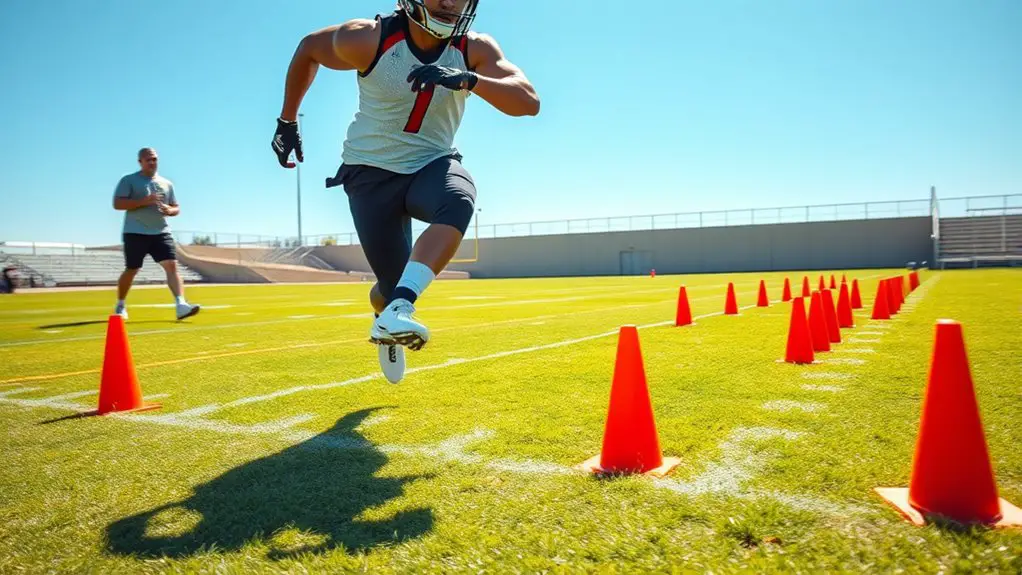Plyometrics can seriously boost your explosiveness on the soccer field. These dynamic exercises improve your power, agility, and speed by targeting fast-twitch muscle fibers. You'll find that incorporating exercises like box jumps and depth jumps helps enhance your sprinting, tackling, and shooting capabilities. Plus, plyometrics aid in injury prevention by strengthening your joints. If you want to discover effective ways to integrate these exercises into your training, there's much more to explore.
Understanding Plyometrics and Their Mechanism
When you think about enhancing your soccer performance, understanding plyometrics is key. Plyometrics involve exercises designed to improve your explosive mechanics, allowing you to generate power quickly. At the heart of plyometric principles is the stretch-shortening cycle, where your muscles stretch and then contract rapidly, enabling you to jump higher and sprint faster. Imagine harnessing that energy to break past defenders or leap for headers; it's all about maximizing your body's natural capabilities.
Incorporating plyometric training into your routine isn't just about doing box jumps or burpees; it's about mastering the technique. Focus on the quality of your movements, ensuring you engage your muscles effectively. By doing so, you'll enhance your responsiveness on the field, giving you the freedom to move dynamically and react better to game situations. Increased power through the development of fast-twitch muscle fibers will elevate your performance. Embrace the power of plyometrics, and watch your soccer skills soar!
Benefits of Plyometric Training for Soccer Players
Plyometric training can seriously boost your performance on the soccer field. You'll see enhanced power generation, improved agility and speed, and even strategies for injury prevention. Let's explore how these benefits can transform your game. Additionally, incorporating plyometric exercises into your routine can significantly enhance explosiveness, which is crucial for maximizing performance in any sport.
Enhanced Power Generation
Although many factors contribute to a soccer player's performance, enhanced power generation through plyometric training stands out as a game-changer. By incorporating explosive movements like jumps and bounds, you're not just building muscle; you're increasing your power output. This boost in explosive strength directly translates to your ability to sprint, tackle, and shoot with intensity. You'll find that plyometric exercises engage fast-twitch muscle fibers, helping you release that raw energy when it matters most on the field. Imagine having the freedom to accelerate past opponents or deliver powerful shots without hesitation. With consistent plyometric training, you can elevate your game, making every move count. Embrace this training and watch your performance soar!
Improved Agility and Speed
The benefits of plyometric training extend beyond just power generation; they also greatly enhance agility and speed on the field. By incorporating agility drills into your routine, you'll not only improve your footwork but also your ability to change direction quickly. This is essential in soccer, where being nimble can make all the difference during tight plays. Speed workouts, when combined with plyometric exercises, help develop fast-twitch muscle fibers, giving you that edge when sprinting down the pitch. You'll find yourself evading defenders and closing gaps with ease. Embrace these training methods, and you'll feel more explosive and free on the field, releasing your full potential in every match. Your rivals won't know what hit them!
Injury Prevention Strategies
Incorporating plyometric training into your routine not only boosts your performance but also plays an essential role in injury prevention for soccer players. By enhancing your strength and power, plyometrics helps stabilize your joints, reducing the risk of common injuries like ankle sprains and knee issues. You'll develop better body awareness, which translates to improved movement mechanics on the field. Additionally, combining plyometrics with effective recovery strategies, such as stretching and foam rolling, can further enhance your resilience. This holistic approach not only keeps you fit but also allows you to enjoy the freedom of playing without the constant fear of injury. Embrace plyometrics to stay explosive while safeguarding your body from the wear and tear of the game.
Key Plyometric Exercises for Enhanced Explosiveness
Plyometric exercises are an important component for soccer players aiming to boost their explosiveness on the field. Incorporating box jumps and depth jumps into your routine can enhance your vertical leap, while hurdle hops and single leg bounds improve your agility and power. Tuck jumps and lateral jumps help develop quickness in changing directions, vital for evading defenders. Don't forget about upper body strength; explosive push-ups and medicine ball throws can greatly contribute to your overall explosiveness. Adding agility drills will refine your footwork and speed, essential for sprint starts. Additionally, focusing on plyometric exercises can engage fast-twitch muscle fibers for increased speed and explosive power.
Integrating Plyometrics Into Soccer Training Regimens
To maximize the benefits of plyometrics, integrating these explosive exercises into your soccer training regimen is key. Start by incorporating a plyometric progression that aligns with your current fitness level. This means gradually increasing the intensity and complexity of your exercises, which helps prevent injury while enhancing your performance. Aim for a training frequency of two to three times a week, allowing your body ample recovery time between sessions.
Mix in exercises like box jumps, depth jumps, and bounds with your regular drills. You can spice things up by pairing plyometrics with agility drills or ball work, keeping your training engaging and dynamic. Always listen to your body; if you feel fatigued, take a step back. The goal is to develop explosive power without compromising your overall training or risking burnout. By thoughtfully integrating plyometrics, you'll release your full potential on the field. Additionally, exercises like calf raises can further enhance your overall explosiveness and stability during play.
Measuring Progress and Performance Improvements
While you're integrating plyometrics into your training, measuring your progress is essential to understanding how these exercises are enhancing your performance on the field. Start by setting specific goals—whether it's increasing jump height, improving sprint times, or enhancing agility. Use progress tracking tools like timing gates or vertical jump testers to collect data regularly.
Performance metrics can help you see where you're excelling and where you might need to focus more effort. For instance, compare your results week over week to identify trends. Are you getting quicker? Jumping higher? This feedback not only validates your hard work but also keeps you motivated. Additionally, including acceleration drills in your regimen can provide a more comprehensive view of your speed development.
Common Mistakes to Avoid in Plyometric Training
When engaging in plyometric training, it's easy to make mistakes that could hinder your progress or lead to injury. One common misstep is pushing too hard without allowing for proper recovery. Ignoring recovery importance can increase overtraining risks, leaving you fatigued and more prone to injuries. It's essential to listen to your body and incorporate rest days into your routine.
Another mistake is focusing solely on intensity without ensuring proper form. Poor technique can not only compromise your results but also put unnecessary strain on your joints. Always prioritize quality over quantity in your jumps and landings.
Lastly, don't skip the warm-up. A proper warm-up prepares your muscles and joints, reducing injury risks. Engaging in dynamic stretching before your plyometric sessions can enhance your performance and readiness. Plyometric training can be liberating, but only if you approach it wisely. By avoiding these common pitfalls, you'll maximize your explosiveness while keeping your body safe and healthy.
Case Studies: Success Stories of Plyometric Implementation
Let's take a look at some impressive case studies that showcase how plyometrics can transform athletes and elevate team performance. You'll see firsthand how incorporating these explosive exercises has led to remarkable improvements on the field. These success stories highlight the real impact of plyometric training in soccer. Notably, athletes who integrated plyometric exercises for power into their training routines experienced significant enhancements in their overall explosiveness and agility.
Notable Athlete Transformations
Plyometrics have proven to be a game-changer for many athletes, especially in soccer, where explosiveness can define a player's performance on the field. Take a look at transformation stories like that of a young midfielder who struggled to keep up with faster opponents. After incorporating plyometric drills into his routine, he saw a significant boost in his sprint speed and agility, leaving his competition in the dust. Athlete comparisons further highlight these transformations, showcasing players who've leaped from benchwarmers to starters, thanks to focused plyometric training. With dedication, you can also experience this kind of growth. Remember, each jump and bound is a step toward releasing your full potential on the pitch. Embrace the journey!
Enhanced Team Performance
As teams increasingly seek ways to enhance performance, many have turned to plyometric training, witnessing remarkable results in their overall play. By integrating plyometrics, teams have improved their team dynamics and achieved greater tactical synergy on the field.
Consider these success stories:
- Increased Speed: Players report faster sprinting times, helping them outrun opponents.
- Higher Jumping Ability: Enhanced vertical leaps lead to more successful headers and defensive plays.
- Improved Coordination: Players' agility and coordination have sharpened, allowing for fluid ball movement and teamwork.
These benefits not only boost individual performance but also create a cohesive unit that thrives under pressure. If you're looking to elevate your game, plyometrics might just be the key to revealing your team's potential.
Frequently Asked Questions
How Often Should Soccer Players Perform Plyometric Training Weekly?
You might wonder how often you should include plyometric training in your routine. Frequency guidelines suggest aiming for 1 to 3 sessions per week, depending on your training volume and overall fitness level. It's crucial to listen to your body, ensuring you have enough recovery time between sessions. This way, you can maximize your explosiveness while enjoying the freedom to train without overdoing it. Balance is key to maintaining your enthusiasm and performance!
Can Plyometrics Increase Agility in Addition to Explosiveness?
You might've noticed that agility drills often involve explosive movements, right? Well, you're spot on! Plyometrics can absolutely boost your agility alongside explosiveness. By incorporating exercises like box jumps and lateral bounds into your training, you'll enhance your quickness and coordination on the field. This added agility can give you the freedom to change direction swiftly, making you a more dynamic player. So, embrace plyometrics and watch your game elevate!
Are There Age Restrictions for Starting Plyometric Training?
There aren't strict age restrictions for starting plyometric training, but safety guidelines suggest considering your training age. If you've got a solid foundation in strength and flexibility, you can safely begin plyometrics, typically around age 12. It's important to listen to your body and progress gradually. You'll want to focus on proper technique to minimize injury risk. Ultimately, it's about finding the right balance between challenge and safety for your individual journey.
How Do Nutrition and Recovery Impact Plyometric Effectiveness?
You might think you can skip nutrition and recovery and still get explosive results—surprise! That's not how it works. Proper nutrition timing fuels your workouts and helps your muscles recover efficiently. Without it, you're just playing a game of chance. Recovery strategies, like rest and stretching, are crucial to allow your body to adapt and grow stronger. So, if you want to truly maximize your plyometric gains, don't overlook these essential components!
Can Plyometrics Be Beneficial for Youth Soccer Players?
Absolutely, plyometrics can be beneficial for youth soccer players! These training techniques enhance strength and agility, essential for their development. By incorporating explosive movements, you'll help them improve their performance on the field while also fostering a love for the game. It's important to guarantee that exercises are age-appropriate and fun, allowing them to engage freely in their training. With the right approach, you can support their growth and passion for soccer!




